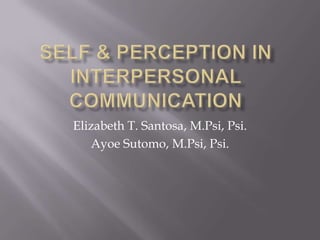
Understanding Your Self Concept
- 1. Elizabeth T. Santosa, M.Psi, Psi. Ayoe Sutomo, M.Psi, Psi.
- 2. The way you see yourself Consist of your feelings and thoughts about your strengths and weakness. Develop from: Others images of you Social comparison Cultural teaching Your own interpretation & evaluation
- 3. Your insight into & knowledge about yourself. Understanding how your self concept develops in one way to increase your self awareness. Four selves (Johari Window) 1.The Open self All the information, behavior, attitudes, feelings, desires, m otivation, and ideas that you and others know. Ex: name, skin color, sex, age, religion. 2. The Blind Self Represent all the things about yourself that others know but of which you’re ignorant. Ex: habit, distinct body odor,
- 4. 3. The Hidden Self All that you know your self and of others that you keep secret. Over discloser = tell all Under discloser = tell nothing Selective discloser = keep certain things hidden and disclose others; they make disclosures to some people and not to others 4. The Unknown Self Represent truths about yourself that neither you or others know. Revealed through temporary changes brought about special experimental condition, such as hypnosis.
- 5. Increasing Self Awareness: Ask about yourself Listen to others Actively seek information about yourself See your different selves Increase your open self
- 6. The value you see yourself Ex:How much do you like yourself? How valuable a person do you think you are? How competent do you think you are? Attack your self destructive believes: (The drive to be perfect; The drive to be strong; The drive to please; The drive to hurry up; The drive to try hard) Secure affirmation : Ex: I am worthy person; I am responsible and can be dependent upon; I am capable of loving and being love; I deserved good things to happen to me; I can forgive myself for mistakes and missjudgement.
- 7. Seek out nourishing people Noxious: criticize and find fault with just about everything Nourishing people: optimist, reward, make you feel good about your self. Work on project that will result in success
- 8. Definition: Communicating information about yourself to another person. It may information about: Your value, beliefs and desires Your behavior Your self qualities or characteristics Verbally or nonverbally. Reason for self-disclose: Catharsis To make yourself look good To help the listeners To maintain or repair a relationship
- 9. Influence self disclosure: Who you are Your culture Your gender Your listeners Your topic and channel Rewards of Self Disclosure Selfknowledge Communication and relationship effectiveness Psychological health
- 10. Dangers of self disclosure: Risks Ahead Personal risks Relational risks Professional risks
- 11. Deciding wheter and how to self-disclose; responding to the disclosures of others; resisting pressures to self-disclosure Please considers things below: 1. Motivation for self-disclose 2. Appropriateness of the self-disclose 3. Disclosures of the other person 4. Possible burdens self-disclosure might entail 5. Facilitating and responding to self-disclosures
- 12. Cont: 6. Skills of effective and active listening 7. Support and reinforce the discloser 8. Be willing to reciprocate 9. Keep the disclosures confidential 10. Dont use the disclosures against the person 11. Guidelines for resisting Self-Dislosure 12. Dont be pushed 13. Be assertive in your refusal to disclose 14. Be indirect and move to another topic
- 13. A state of fear or anxiety about communication interaction . Trait apprehension : fear of communication generally State apprehension: fear of communication in specific communication
- 14. Degree of evaluation Subordinate status Degree of conspicuousness Degree of unpredictability Degree of dissimilarity Prior successes and failures Lack of communication skill and experience
- 15. Cognitive restructuring Systematic desensitization Skill acquisition Prepare and practice Focus on success Familiarize yourself with the situation
- 16. Definition: The process by which you become aware of objects, events, and especially people through your senses: sight, smell, taste, touch, and hearing. Active process Stages of perception: 1: Stimulation Selective exposure: you expose yourself to people, messages, that will confirm your existing beliefs, contribute to your objects and prove satisfying in some way. 2: Organization Organization by rules Organization by schemata Organization by script
- 17. 3: Intrepretation – Evaluation 4: Memory 5: Recall
- 18. Self fulfilling prophecy (pygmalion effect) Prediction that came true because you act on it as if it were true. Implicit Personality Theory The system of rules that tells you which characteristics go with which other characteristics. Hallo effect vs Reverse Hallo Perceptualaccentuation Primacy – Regency Consistency
- 19. Attribution Attribution process Consensus: Similarity with Others Consistensy: Similarity in different situation Distinctiveness: Similarity in Different Situation Controllability: Behavior Control Attribution Errors Self serving bias Fundamental attribution error Overattribution
- 20. Analize perception Check perception 1. Describe what you see or hear, recognizing that description are not really objective but are heavily influenced by who you are, your emotional states, and so on. 2. Seek confirmation. Reduce uncertainly Increace Cultiral Sensitivity
- 21. Give example about your self concept, self awareness, and self esteem!
